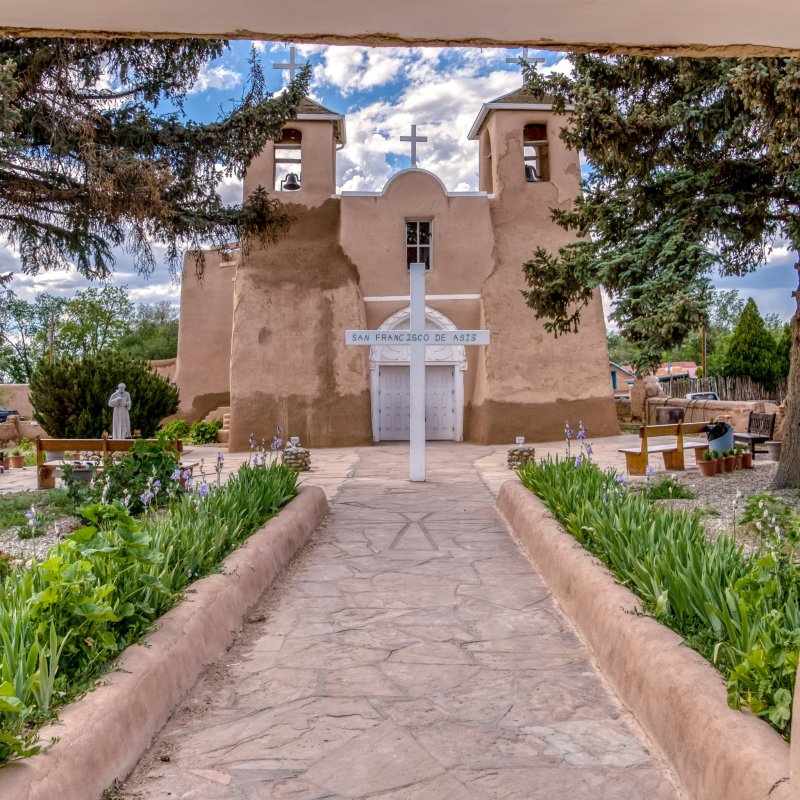
Offering history, culture, religion, and architecture, the high desert between Santa Fe and Taos is a wonderful place for a road trip. Along the High Road from Santa Fe to Taos, you’ll pass through remote mountain villages with Spanish colonial roots, see Pueblo enclaves, visit a chapel that’s thought to hold healing earth, take in spectacular views, and explore local arts.
Videos by TravelAwaits
The drive from Santa Fe to Taos is 105 miles and takes about 2.5 hours to complete without stopping, but the many sights along the route demand a slower pace. This scenic byway winds through the heart of the Sangre de Cristo Mountains and is absolutely breathtaking. It’s a good trip at any time of year, but especially from mid-May through October, when there are sunny skies nearly every day.

Santa Fe
Santa Fe, founded in 1610, is the oldest capital city in the United States. The city is rich in history and architecture and boasts wonderful museums, arts, and churches.
Some not-to-be-missed museums include the New Mexico Museum of Art, the Museum of International Folk Art, and the Georgia O’Keeffe Museum, among many others. Along Canyon Road and throughout the downtown area are numerous art galleries.
If old churches interest you, you’ll want to visit the Shrine of Our Lady of Guadalupe, the Cathedral Basilica of Saint Francis of Assisi, and the Loretto Chapel. The San Miguel Chapel, the oldest church in the U.S., is a must-see.
The first place I traveled as a travel writer was Santa Fe. I fell in love with this historic city and have since returned numerous times. One of the reasons I went originally was to experience the hot springs I’d heard so much about from my mother. Her tales of trekking through the snow to slide into the warm waters with friends had me intrigued. If you’re interested in trying out the healing waters of a hot spring, visit Ten Thousand Waves, or seek out one of these area springs.
Santa Fe offers plenty of opportunities to sample New Mexican cuisine. Blue corn tortillas, red and green chile sauces, posole, and beans are served at many restaurants. The Shed and Tomasita’s, both located on the Plaza, are two of my favorites. For more on Santa Fe’s delightful cuisine scene, see this piece.
There are a plethora of unique lodging options in Santa Fe. I’ve stayed at accommodations ranging from a hostel to a $500/night townhome and everything in between. Two of my favorites are Inn of the Governors and La Fonda on the Plaza. Plan to stay a few nights to really immerse yourself in this eclectic city.
Pro Tip: Santa Fe is a great vacation destination for travelers trying to save money. If you’re traveling on a budget, read this piece.

Chimayo
Before setting off on the High Road to Taos, I recommend purchasing a paper map. During one of my visits to the area, my sister and I headed to Chimayo and made a wrong turn along the way. We lost cell service, and the GPS on my phone wouldn’t work. Luckily, we wound up finding a postal worker who gave us directions, but I won’t take my chances without a paper map again.
Once in Chimayo, enjoy lunch at Rancho de Chimayo, a long-standing Pueblo-style restaurant where you can eat indoors or outside on the garden patio.
The town of Chimayo is known for its small adobe church that is believed to have healing properties. Pilgrims visit El Santuario de Chimayo to pray, walk the grounds and gardens, and gather healing dirt from a hole inside the church. You’ll see hundreds of crosses hung along the paths and walls.
Chimayo’s Plaza del Cerro is the Southwest’s last surviving Spanish fortified plaza. The town is also famous for the weavings made by the Ortega and Trujillo families, whose work can be found at many shops.
If you want to spend more time at El Santuario de Chimayo, visit the Chimayo Museum, or hike around the Santa Cruz Lake Recreation Area, consider spending the night at Casa Escondida. This bed and breakfast with nine guest rooms is located on 6 acres with mountain views.
Cordova, Truchas, And Ojo Sarco
Past Chimayo, stop in the towns of Cordova, Truchas, and Ojo Sarco, where you can explore dozens of galleries offering woodcarvings, pottery, rugs, and other local arts and crafts. In Ojo Sarco, be sure to visit the artists’ studios. Cordova is known for its many woodcarvers.

Las Trampas
Stop in Las Trampas to visit one of New Mexico’s best-preserved examples of Spanish colonial architecture — San Jose de Gracia. The church is a National Historic Site and is still in use after 250 years.

Penasco
One of the largest historic villages in the mountains south of Taos, Penasco sits at the foot of Jicarita Peak. The area is rich in geological history — the rounded boulders were formed millennia ago when the glaciers that covered the region wore the rocks smooth.
The Picuris Pueblo is one of the oldest continually occupied settlements in North America. In the 1960s, the area became the center for the Southwest Hog Farm, a commune for artists, musicians, farmers, and those with alternative lifestyles.

Carson National Forest
For 30 scenic miles, you’ll drive through parts of the Carson National Forest. Stop and take a nature break on some of the 330 miles of trails. In the winter, many of these trails become cross-country ski and snowmobile trails. One of five national forests in New Mexico, Carson National Forest is located on 1.5 million acres, where elevations rise from 6,000 feet to 13,161 feet at Wheeler Peak, the highest point in New Mexico.
If you enjoy fishing, there are 400 miles of clean mountain streams plus numerous lakes, many stocked with native trout by the New Mexico Department of Game & Fish.
If you have camping gear with you, you can camp on one of the many established campgrounds, or if you’re adventurous, you can try backcountry car camping.

Ranchos De Taos
Numerous artists and photographers, including Georgia O’Keeffe and Ansel Adams, have captured the essence of the San Francisco de Asis Church in Ranchos de Taos. The tiny village, just 4 miles south of Taos, has plenty of galleries and shops to explore. The plaza was the most populated community in the area during the mid-1700s. Some of the buildings still feature parts of the original structures.

Taos
Taos is an artist haven with a laid-back vibe and a multitude of art museums, galleries, shops, and restaurants.
One notable stop in Taos is the Taos Pueblo, the only living Native American community designated both a UNESCO World Heritage site and a National Historic Landmark. The adobe dwellings have been inhabited for more than 1,000 years.
The historic Taos Plaza houses galleries, restaurants, and shops. A variety of guided tours showcase the diversity of the region, including walking tours of historic Taos, ghost tours, and winery tours. On the Moonfire Tours, you can learn about the region’s ancient cultures and history.
Taos is known for its locally grown foods, and many restaurants serve up food that has traveled less than 2 hours from farm to table. Sugar Nymphs Bistro offers gourmet comfort food made with local produce. For New Mexican cuisine, try Ranchos Plaza Grill — especially the famous sopapillas!
For rustic charm and an artistic atmosphere at the end of your journey, stay at the historic Mabel Dodge Luhan House. Artistic, literary, and personal growth workshops are available. Stay in the Solarium room that was formerly the sun porch; it’s an airy room surrounded by glass.
If a bed and breakfast is more your speed, consider the Blue Sky Retreat Center at the San Geronimo Lodge, where every room is uniquely decorated. The lodge was built in 1925 and features high ceilings, rambling verandas, and 3.5 acres of grounds.
Pro Tip: Return to Santa Fe via the Low Road (sometimes called the River Road). This is a more direct route that follows the Rio Grande. Stop by the Rio Grande Gorge Visitor Center to learn more about the area.
